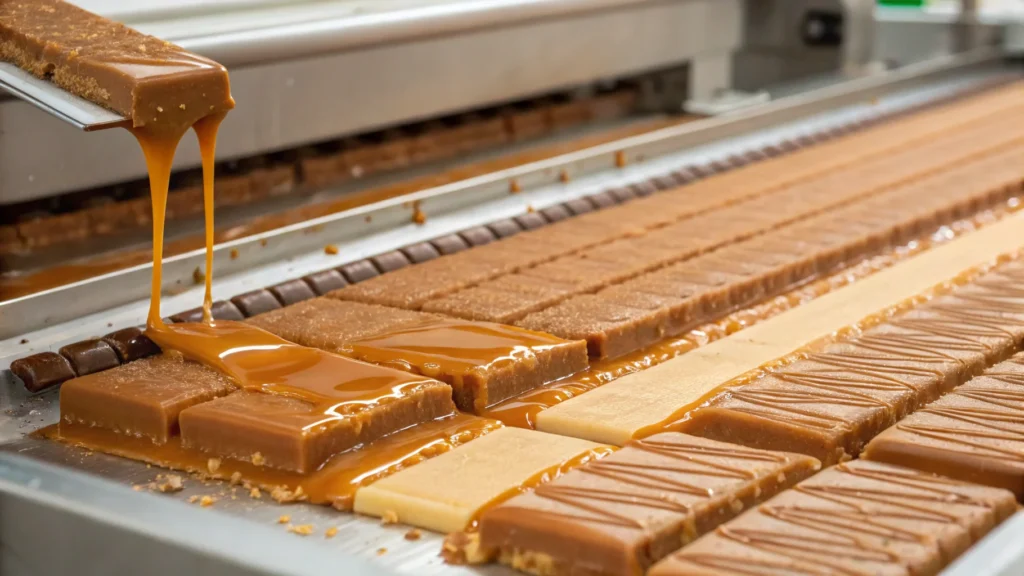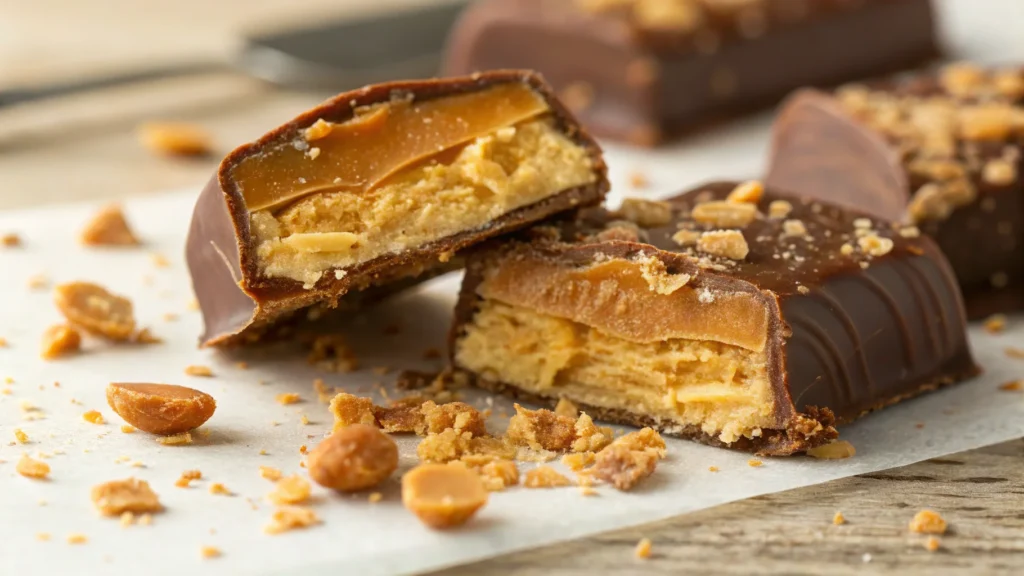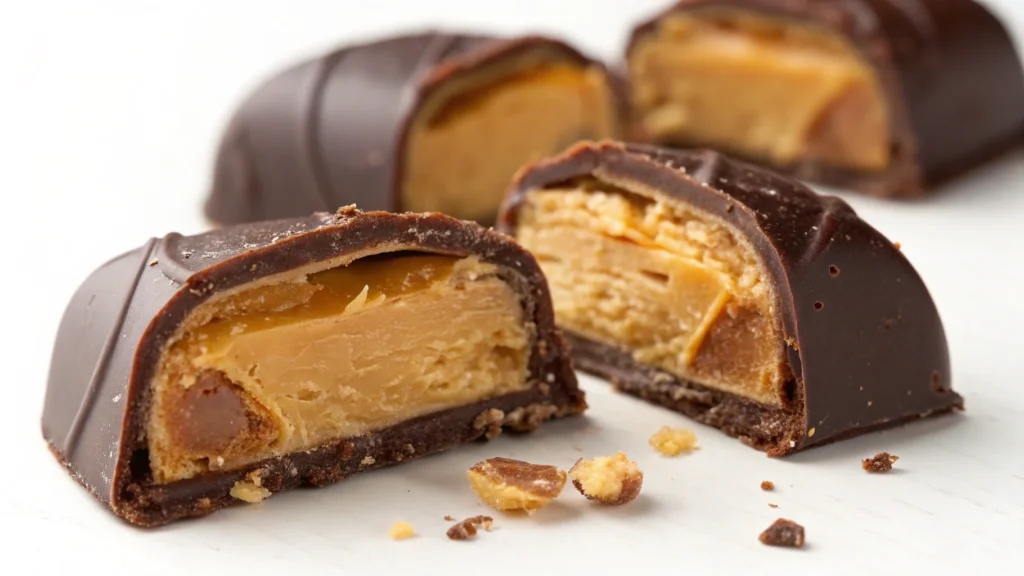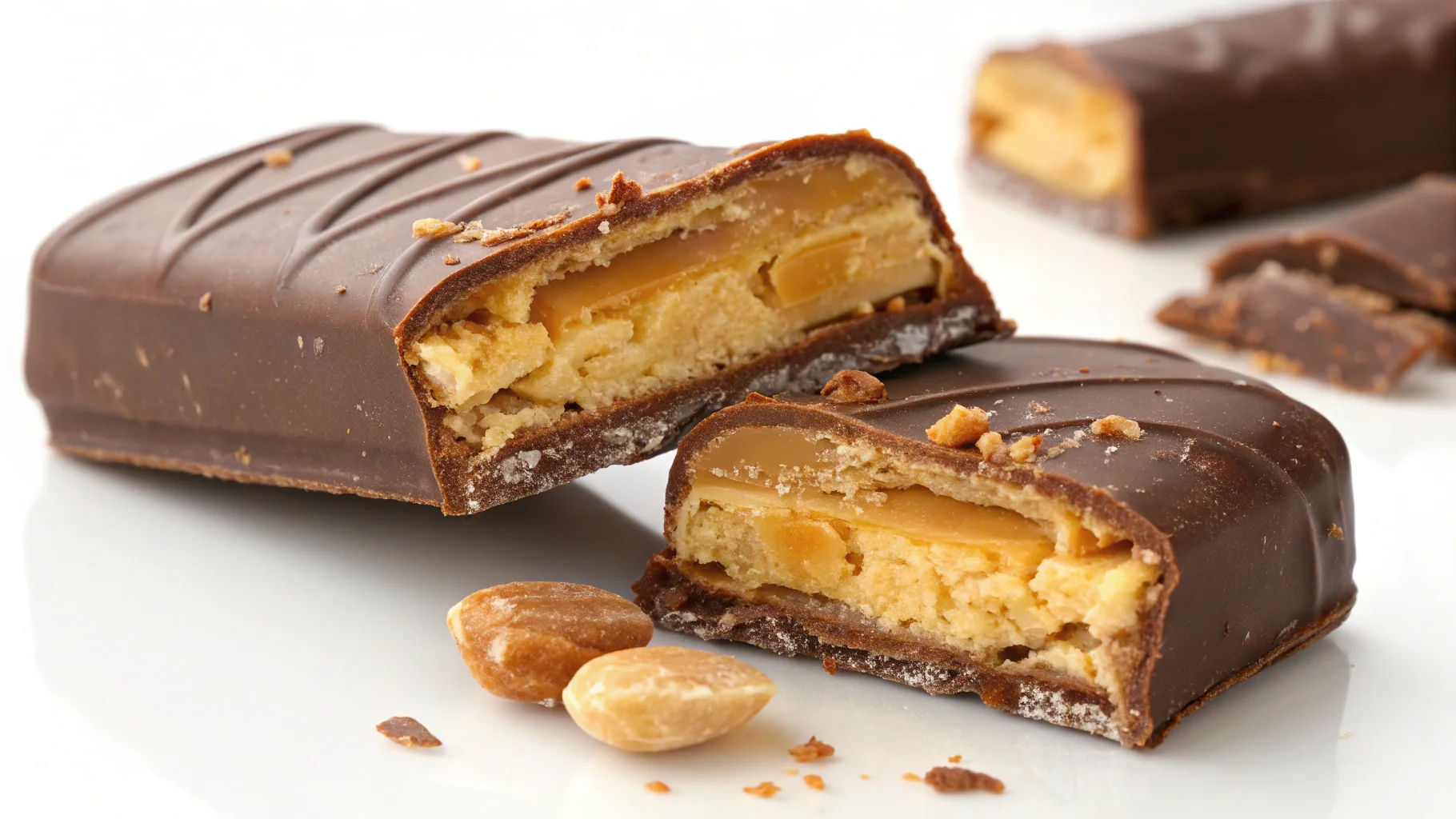Butterfinger is famous for its crispy, flaky peanut butter layers wrapped in a smooth chocolate coating. But what exactly gives it that signature crunch? Unlike other peanut butter candies, Butterfinger doesn’t have a creamy or nougat-like filling—it has a light, crispy, and shatteringly delicate texture that makes it truly unique.
If you’ve ever bitten into a Butterfinger and wondered, “What is the flaky stuff in Butterfingers?” you’re not alone. The answer lies in a special candy-making process that creates thin, aerated layers of peanut butter-infused brittle.
Table of contents
- What Is the Flaky Stuff in Butterfingers?
- Step-by-Step: How Butterfinger Gets Its Flaky Texture
- Why Is Butterfinger So Crispy Instead of Chewy?
- What Is the Hard Stuff in Butterfingers?
- What Is the Crispy Part of a Butterfinger?
- What Is the Filling in Butterfinger?
- FAQs About Butterfinger’s Texture
- Why Does Butterfinger Have a Unique Texture?
- Why Did Butterfinger Change Its Recipe
- Conclusion: The Secret Behind Butterfinger’s Crispy, Flaky Texture
What Is the Flaky Stuff in Butterfingers?
The crispy layers inside a Butterfinger aren’t just peanut butter. Instead, they’re made of thin, aerated layers of caramelized sugar and peanut butter, folded together to create the perfect crunchy bite.
The Key Components of Butterfinger’s Flaky Texture
To create that signature crunchy peanut butter filling, Butterfinger uses a few key ingredients:
– Sugar & Corn Syrup – Forms a hard, brittle base for the layers.
– Peanut Butter – Adds a nutty flavor and smoothness.
– Molasses & Salt – Enhances the depth of flavor.
– Baking Soda – Creates tiny air pockets, making the texture light and flaky.
The combination of high-temperature sugar cooking and aeration gives Butterfinger its crunchy yet delicate structure.
The Science Behind the Flaky Layers
Butterfinger’s crispy filling isn’t just mixed together like a regular peanut butter candy. Instead, it’s made using a technique called lamination, similar to how puff pastry or croissants are made.
Here’s how it works:
1️⃣ A hot sugar syrup is cooked to 300°F (known as the “hard crack stage”), making it brittle and crisp.
2️⃣ Peanut butter is folded in while the mixture is still hot.
3️⃣ The candy is stretched and folded multiple times to create thin, delicate layers.
4️⃣ Baking soda is added, creating tiny bubbles inside the candy, which gives it a light, flaky texture.
Because of this layering and aeration process, Butterfinger has a unique crunch that melts in your mouth—unlike any other peanut butter candy!
Why Is Butterfinger So Different from Other Peanut Butter Candies?
Most peanut butter candies, like Reese’s Cups or peanut butter nougats, have a smooth and creamy texture. Butterfinger, on the other hand, has a light, crispy bite because of its laminated, aerated candy structure.
| Candy Type | Texture | How It’s Made |
|---|---|---|
| Butterfinger | Crispy, flaky, and crunchy | Laminated peanut butter and sugar layers, aerated for crispness |
| Reese’s Cups | Creamy and smooth | Soft peanut butter mixed with sugar and stabilizers |
| Peanut Brittle | Hard and crunchy | Cooked sugar and peanuts, but no aeration or layering |
This unique texture is what sets Butterfinger apart from other peanut butter candies, making it one of the most iconic candy bars ever made!
How Is the Butterfinger Filling Made?
Now that we know the flaky stuff in Butterfingers comes from thin, crispy layers of peanut butter-infused brittle, let’s dive into the step-by-step process of how this unique texture is created.
Unlike other candy bars with creamy peanut butter fillings, Butterfinger’s crispy center is made using a lamination process—a technique similar to making puff pastry or croissants but applied to candy-making.

Step-by-Step: How Butterfinger Gets Its Flaky Texture
The secret behind Butterfinger’s signature crunch lies in how the peanut butter and sugar mixture is handled. Here’s how it’s made:
1. Heating the Sugar Syrup to Create a Brittle Base
- The process starts by cooking a sugar mixture made from:
– Corn syrup – Helps bind ingredients together.
– Molasses – Adds depth of flavor and color.
– Granulated sugar – Caramelizes to create a brittle texture. - This mixture is heated to 300°F (hard crack stage), ensuring it will harden and stay crisp instead of turning chewy.
2. Adding Peanut Butter to the Hot Sugar Mixture
- While the sugar mixture is still hot, creamy peanut butter is added.
- The peanut butter must be carefully incorporated so that it doesn’t melt completely into the sugar, preserving some of its nutty texture.
3. The Secret to Flakiness: The Lamination Process
Here’s where the magic happens! To create the light, crisp layers, the peanut butter and sugar mixture undergoes a process called lamination:
– The hot mixture is stretched and folded multiple times.
– This repeated folding creates thin, delicate layers of peanut butter and sugar.
– Baking soda is added, releasing tiny air bubbles that make the candy lighter and crispier.
Just like how pastry dough gets flaky from layers of butter, the Butterfinger center gets crispy from this layered sugar-and-peanut butter structure.
4. Cooling & Cutting into Bars
- Once the peanut butter brittle mixture reaches the right crispy consistency, it is cooled.
- The mixture is then rolled into thin sheets and cut into rectangular bar shapes.
5. Coating in Chocolate
- Each flaky Butterfinger bar is then dipped in smooth milk chocolate, which helps:
– Keep the crispy center intact
– Add a sweet, creamy contrast to the crunchy filling
– Prevent the peanut butter layers from drying out too much
The final result? A perfectly crisp, peanut-buttery bite wrapped in rich chocolate!
Why Is Butterfinger So Crispy Instead of Chewy?
The reason Butterfinger has a crispy, break-apart texture instead of a chewy or smooth peanut butter filling comes down to:
1. High-Temperature Sugar Cooking
- The sugar is cooked to 300°F, ensuring it hardens instead of softening.
2. Air Pockets from Baking Soda
- The addition of baking soda creates small bubbles inside the sugar mixture, making the candy lighter and crispier rather than dense and chewy.
3. Laminated Layers
- Unlike chewy caramels, which are stirred continuously, Butterfinger’s filling is folded into layers, preserving crispness and flakiness.
What Is the Hard Stuff in Butterfingers?
Now that we know how Butterfinger’s flaky, peanut butter layers are created, you might be wondering:
“Why does Butterfinger have such a hard, crunchy texture instead of being soft or chewy?”
The hard, brittle texture of Butterfinger’s filling comes from sugar caramelization and aeration. The combination of high-temperature sugar cooking, air pockets, and layering creates the candy’s signature crisp, shattering crunch.
Why Is Butterfinger’s Filling Hard and Crunchy?
Unlike other peanut butter-based candies that are smooth and creamy, Butterfinger’s center is firm and brittle due to:
– The Sugar Cooking Process – Sugar is heated to a high temperature, causing it to harden instead of becoming chewy.
– Air Pockets from Baking Soda – Tiny bubbles form inside the layers, making the texture light and crisp rather than dense.
– Caramelization of Sugar – When sugar is heated past a certain point, it becomes brittle and shatters when broken.
This combination gives Butterfinger its unique, crispy texture that’s different from any other peanut butter candy.
Step-by-Step: How Butterfinger’s Hard Texture Is Created
1. Cooking Sugar to the Hard Crack Stage (300°F)
- Butterfinger’s filling starts as a mixture of corn syrup, molasses, and granulated sugar.
- This mixture is heated to 300°F (hard crack stage), which ensures the sugar becomes brittle and snappy instead of chewy.
2. Rapid Cooling to Lock in Crispness
- Once the sugar mixture reaches the right temperature, it is quickly cooled to prevent it from becoming sticky or soft.
- This rapid cooling process locks in the hard, shatter-like texture.
3. Aeration with Baking Soda
- Baking soda is added during the final cooking stage, causing the mixture to foam up slightly.
- This creates tiny air pockets, which make the candy crunchy but not rock-hard.
4. Stretching and Folding the Mixture
How Does Butterfinger Compare to Other Hard Candies?
| Candy Type | Texture | How It’s Made |
|---|---|---|
| Butterfinger | Flaky, crunchy, breakable | Laminated peanut butter brittle |
| Peanut Brittle | Hard, solid, and dense | Cooked sugar and peanuts, no aeration |
| Toffee | Chewy, sticky | Butter and sugar caramelized together |
Unlike peanut brittle, which is extremely hard, Butterfinger is lighter and more delicate because of the lamination and air bubbles.
Why Doesn’t Butterfinger Melt in Your Mouth Like Other Peanut Butter Candies?
Butterfinger doesn’t melt as easily as other peanut butter candies because of:
– Its high sugar content – Sugar hardens at high temperatures, preventing melting.
– The air pockets inside – These reduce density, keeping the candy crisp.
– The chocolate coating – This acts as a protective layer, locking in the texture.

What Is the Crispy Part of a Butterfinger?
We’ve already uncovered the secret behind Butterfinger’s flaky peanut butter layers and why its texture is hard and crunchy. But what exactly makes the crispy part of a Butterfinger so unique?
Unlike a traditional peanut butter filling, which is typically creamy or smooth, Butterfinger’s crispy center is created through a laminated candy-making process. This technique gives the candy its distinct, shatteringly crisp texture that melts in your mouth.
What Makes Butterfinger’s Center So Crispy?
The crispy part of a Butterfinger is made from thin layers of peanut butter-flavored candy, which are created by:
– Cooking sugar and corn syrup to a hard-crack stage (300°F)
– Folding in peanut butter while the mixture is still hot
– Stretching and folding the mixture multiple times to create layers
– Adding baking soda to aerate the candy, making it light and crispy
This process locks in air pockets, preventing the candy from becoming dense. The result? A light, delicate, and crispy texture that gives Butterfinger its signature snap when you bite into it.
How Does Butterfinger’s Crispiness Compare to Other Candies?
| Candy Type | Texture | Why It’s Crispy |
|---|---|---|
| Butterfinger | Light, flaky, and crispy | Laminated peanut butter candy with aeration |
| Peanut Brittle | Hard and dense | Cooked sugar and peanuts, no layering |
| Crunch Bar | Crispy but not flaky | Puffed rice mixed with chocolate |
| Toffee | Hard but slightly chewy | Caramelized butter and sugar |
Unlike peanut brittle, which is dense and solid, Butterfinger’s filling has a more delicate, airy crispness.
The Role of Baking Soda in Butterfinger’s Crispiness
One key ingredient that makes Butterfinger crispy is baking soda. Here’s why it’s important:
– Creates Air Pockets – Baking soda reacts with the hot sugar mixture, forming tiny gas bubbles that prevent the candy from becoming too dense.
– Adds Lightness – Without baking soda, Butterfinger’s filling would be hard and tough, instead of flaky and delicate.
– Enhances Flakiness – The aeration process helps form the thin, crispy layers inside the candy.
Without this aeration process, Butterfinger wouldn’t have its signature crunch!
Why Is Butterfinger’s Crispiness So Addictive?
There’s a scientific reason why Butterfinger’s texture is so satisfying:
– Contrast of Crunch & Melt – The flaky layers break apart easily, but then melt in your mouth with the chocolate coating.
– Aerated Texture – The air pockets make the candy lighter, so it doesn’t feel too dense.
– Caramelized Sugar – Gives a deep, rich flavor that enhances the peanut butter taste.
This combination of crispy and melty textures is what makes Butterfinger so irresistible!
What Is the Filling in Butterfinger?
By now, we’ve uncovered the secrets behind Butterfinger’s flaky, crispy texture and hard, crunchy bite. But what exactly is the filling in Butterfinger made of?
Unlike traditional peanut butter fillings, which are smooth and creamy, Butterfinger’s center is made from aerated, caramelized peanut butter candy layers. This special process gives it its signature crispiness that melts in your mouth.
What Ingredients Are in Butterfinger’s Filling?
The Butterfinger filling is made up of a few key ingredients that work together to create its light, crispy texture:
– Roasted Peanuts – Ground into a smooth peanut paste for a rich, nutty flavor.
– Corn Syrup & Sugar – Cooked to the hard crack stage to form the crisp candy structure.
– Molasses & Salt – Adds depth of flavor and enhances the peanut butter taste.
– Baking Soda – Creates tiny air pockets, making the candy light and flaky instead of dense.
– Milk Chocolate Coating – Seals in the crispiness and adds a smooth, sweet contrast.
How Is the Butterfinger Filling Different from Regular Peanut Butter?
| Type | Texture | How It’s Made |
|---|---|---|
| Butterfinger Filling | Flaky, crispy, and crunchy | Laminated peanut butter candy with air pockets |
| Traditional Peanut Butter | Smooth and creamy | Ground roasted peanuts with added oils |
| Peanut Brittle | Hard and dense | Caramelized sugar and peanuts, no aeration |
Unlike regular peanut butter, which is creamy and smooth, Butterfinger’s filling is structured and brittle, thanks to the sugar lamination process.
The Secret Behind the Flaky Peanut Butter Layers
So, how does Butterfinger create thin, crispy peanut butter layers instead of a dense filling?
1️⃣ Cooking Sugar to 300°F – This ensures the sugar hardens instead of staying soft.
2️⃣ Folding in Peanut Butter While Hot – This step locks in the nutty flavor while maintaining separate layers.
3️⃣ Adding Baking Soda – Creates air pockets that make the filling light and flaky.
4️⃣ Stretching & Folding the Mixture – The candy is folded like puff pastry, building layers of peanut butter and caramelized sugar.
This process is what makes Butterfinger’s filling so unique compared to other peanut butter candies.
Does Butterfinger’s Filling Melt in Your Mouth?
Yes! Even though Butterfinger is crispy and flaky, it melts in your mouth due to:
– Thin, delicate layers – Break apart easily for a light, airy texture.
– Chocolate coating – Provides a smooth, creamy contrast to the crunchy filling.
– Aeration process – Keeps the candy from being too hard or dense.

FAQs About Butterfinger’s Texture
Now that we’ve explored the flaky, crispy, and unique peanut butter filling inside Butterfinger, let’s answer some of the most common questions people have about its texture and composition.
1. What Is the Stuff Inside a Butterfinger?
The inside of a Butterfinger is a crispy, flaky peanut butter-flavored candy. It’s made by cooking a sugar mixture to the hard-crack stage, then folding in peanut butter while the candy is still hot. This creates thin, laminated layers that give Butterfinger its signature light and crunchy texture.
2. What Is the Hard Stuff in Butterfinger?
The hard part of Butterfinger comes from caramelized sugar and corn syrup, which are cooked to 300°F (hard-crack stage). This high-temperature cooking process makes the sugar brittle rather than chewy. The filling also contains baking soda, which creates tiny air pockets, making the candy feel crispy but not too dense.
3. What Is the Crispy Part of a Butterfinger?
The crispy part is a combination of caramelized sugar and peanut butter, which is stretched, folded, and aerated to create thin layers. Unlike traditional peanut butter fillings, Butterfinger’s center is light and flaky due to the lamination process.
4. What Is the Filling in Butterfinger?
Butterfinger’s filling consists of:
– Roasted peanuts – Ground into a smooth peanut paste
– Corn syrup & sugar – Forms the crisp candy base
– Molasses & salt – Enhances flavor depth
– Baking soda – Aerates the candy, making it flaky instead of dense
This unique combination gives Butterfinger its one-of-a-kind crunch that sets it apart from other peanut butter candies.
Why Does Butterfinger Have a Unique Texture?
Butterfinger’s texture is a result of high-temperature sugar cooking, aeration, and lamination. Instead of mixing peanut butter and sugar into a soft filling, the ingredients are layered, stretched, and cooled, creating a crispy, flaky bite.
This technique is what makes Butterfinger different from other peanut butter candies, such as Reese’s or peanut brittle.
Why Did Butterfinger Change Its Recipe
Butterfinger has been a fan-favorite candy for decades, known for its flaky, crispy peanut butter filling and smooth chocolate coating. However, in 2018, Butterfinger underwent a recipe change, and many longtime fans noticed a difference in taste and texture.
How Has Butterfinger’s Recipe Evolved Over Time?
Over the years, Butterfinger has undergone subtle changes in its recipe to enhance ingredient quality and flavor. These updates have focused on improving the chocolate coating, peanut butter filling, and overall texture while maintaining the crunchy, flaky layers that fans love.
Key Differences in the Updated Recipe
| Previous Recipe | Updated Recipe |
|---|---|
| Used a sweeter, sugary peanut butter filling | Features a more balanced, nutty peanut butter flavor |
| Chocolate had a slightly waxy texture | Uses creamier, smoother chocolate coating |
| Peanut butter layers were crumbly and dry | Now slightly denser and less crumbly, but still crisp |
| Some artificial ingredients were present | Uses fewer artificial additives for a cleaner taste |
While the candy remains crispy and flaky, some fans have noticed a milder sweetness and a smoother chocolate texture. However, the core laminated peanut butter candy process remains the same, preserving Butterfinger’s distinctive crunch.
Did the Recipe Change Affect Butterfinger’s Crunch?
Yes, but only slightly. While Butterfinger still has its signature flakiness, some fans believe:
– The filling is a bit denser than before.
– The texture is smoother rather than as crumbly.
– The chocolate coating is creamier and less waxy.
However, the overall crispy peanut butter layers remain the same, thanks to the same lamination process used in the original recipe.
Do People Like the New Butterfinger?
The response has been mixed. Some candy lovers appreciate the improved chocolate quality and fresher peanut butter flavor, while others prefer the original, more sugary and crumbly texture.
Despite the changes, Butterfinger remains one of the most unique and beloved peanut butter candies on the market.
Conclusion: The Secret Behind Butterfinger’s Crispy, Flaky Texture
Butterfinger’s signature crunch comes from a unique candy-making process that creates thin, laminated layers of peanut butter-flavored brittle. Unlike traditional peanut butter candies, which are often smooth and creamy, Butterfinger’s filling is aerated, caramelized, and folded to achieve its light, flaky, and crispy texture.
We explored:
– What the flaky stuff in Butterfinger is—a sugar and peanut butter mixture that’s stretched and folded for crispiness.
– How Butterfinger’s filling is made, using high-temperature sugar cooking, lamination, and aeration to create its brittle yet delicate layers.
– Why Butterfinger changed its recipe, improving ingredient quality and chocolate coating, while still maintaining its classic crunch.
Despite minor changes over the years, Butterfinger remains one of the most unique peanut butter candy bars, loved for its flaky, crunchy bite that melts in your mouth.
If you’re a fan of Butterfinger and want to try making a homemade version, check out this DIY Butterfinger recipe to recreate the classic taste in your own kitchen!

